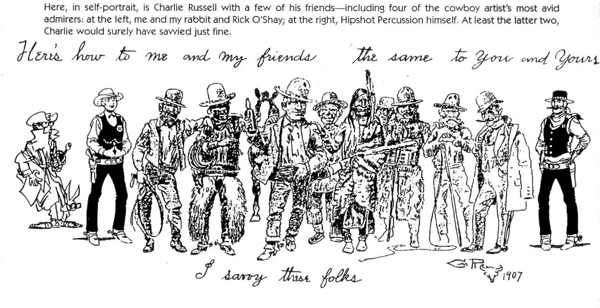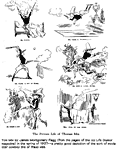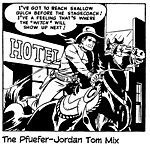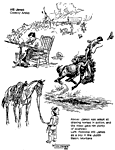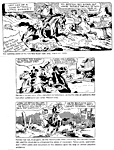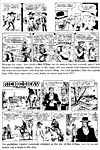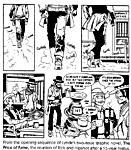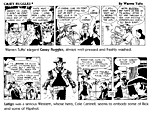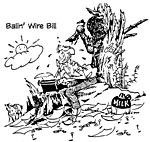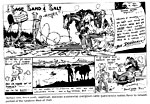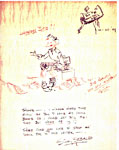Wild ’n’ Woolly American Mythology
A Ramblin’ Look at Cowboyin’ in Strips
In the Hall of Statues just
off the Rotunda of the U.S. Capitol in Washington, D.C., each state is
permitted to place statues of two of its native sons whose lives or works were
somehow worthy of enshrining. These
bronzed personages on pedestals include presidents and statesmen and
general—Washington, Lincoln, Jefferson, Robert E. Lee, and so on. Exactly the kind of roll call you’d
expect. Until you get to Montana.
Montana’s two statues are of Jeannette Rankin and Charles
M. Russell. Never heard of ‘em, you
say? How can they be heroes if they’re
unknown? Depends on your idea of
heroism, I guess.
Jeannette Rankin (1880-1973) was a leader in the women’s
suffrage movement and in 1917 became the first female member of the U.S. House
of Representatives. She served until
1919 and was one of only 50 members of the House to vote against declaring war
on Germany. She was back in the House
in 1941, and when war was declared on Japan following the sneak attack on Pearl
Harbor, she voted against the declaration—and this time, she was the only
dissenting vote. Why? She was a pacifist, first of all; but she
also felt that “a good democracy” should not be on record as voting unanimously
for war.
Charlie Russell (1864-1926) is renowned as the
self-taught “cowboy artist” whose depictions of the old West in watercolor,
oil, pen-and-ink, and in clay and bronze sculptures are highly regarded for
their authenticity. And for their sense
of humor. Before he became famous as an artist, Charlie hunted and trapped,
herded cows, and broke broncs. One
winter, he lived with the Blood Indians in Canada. They gave him the name “Ah-wah-cous,” or antelope (possibly
because the pattern of his riding breeches in the back reminded them of the
south end of an antelope running north). Charlie always spoke of Indians as the only “real Americans,” and he was
an early conservationist and environmentalist (before there was such a term).
A pacifist equal rights advocate and an artist. With heroes like these, Montana is my kind of place.
Russell’s is the only statue of an artist in the
Capitol. Fittingly, the only artist
monumentalized in the Capitol is a cowboy artist: the West, after all, is the most distinctive aspect of American
cultural history, and the history of the country’s expansion into the West—and
the legends and lore associated with that expansion—is the nation’s mythology.
We call this mythology “the Western.” The classic formula—a lone sometime gunman
rides into town and single-handedly defeats the land-hungry mogul or the
marauding band of bad guys or the lurking tribes of blood-thirsty natives—the
formula embodies the spirit of the American experiment. Like the American political experiment, the
Western champions the individual: the former guarantees his rights; the latter
trumpets his prowess, his fitness. Like any good literature, the American
mythology contains an animating conflict. Unlike most literature, however, the conflict in this mythology seldom,
if ever, surfaces. The conflict is
between the individual and society, a conflict inherent in the contradictions
of the formula. Individual rights are
guaranteed by the rule of law; individual prowess, by the rule of individual
might. Each threatens to destroy the
other; neither can triumph while the other survives.
The myth manages this contradiction by never confronting
it. The myth insists that the solitary
champion emerge only when the rule of law has been overthrown. And, once order is restored, the champion
rides off into the sunset—alone—leaving society to thrive now that the rule of
law has been reinstated. Whether the champion could himself thrive under the
rule of law--whether he would, in effect, submit to being ruled by something
other than his own sense of justice--is a question never actually
examined. After all, the champion
usually believes in the rule of law and enacts its spirit (if not its
letter). But with all the power and
resourcefulness he represents, he could, if he wished, stand against that
rule. But in our mythology, he never
does. We invent him in a way that insures that the contradiction never arises.
Invention is the peculiar province of the Western
mythology. Mythology, generally, is the made-up folk version of history; fittingly
enough, two famous persons intimately associated with the West are made-up
people. They invented themselves, and in so doing, they made themselves the
heroes of their own, personal mythologies. Invention is the literary version of
fraud: these guys were hoaxes, pure and simple. One of them—a magnificently
appropriate happenstance, a colossal stroke of poetic justice—was the first
King of the Celluloid Cowboys, a champion fraud in the tinsel capital of
make-believe. Tom Mix (1880-1940).
Mix was, above all else, a showman. In his movies, he
created with flash and action and costume, the movie cowboy. The power of the
motion picture lies in its ability to blur the line between reality and
illusion, and Mix set about doing just that. His big screen personality defined
the future for the Hollywood Western. And in his personal biography, he defined
himself. In his version of his life, he was the epitome of a soldier of
fortune: he went to Virginia Military Academy, fought in the Spanish American
War in Cuba, joined the marines, went to China to fight in the Boxer Rebellion
and was wounded in the chest, returned home, recuperated in time to go to South
Africa to fight in the Boer War, and, when back in the U.S. again, accepted
numerous lawman assignments throughout the West. He was back in uniform for the
Mexican troubles in 1915 or thereabouts, and he somehow acquired all the
riding, roping, bronco-busting, sharp-shooting skills of a cowboy so that when
he arrived in Hollywood, he was ready to assume his on-screen persona. Actually, Tom Mix never attended the Virginia Military
Academy, and although he did enlist in the army at the outbreak of the
Spanish-American hostilities, he served in a regiment whose job was to guard
the DuPont powder works in Delaware. He saw no action. He re-enlisted in 1901,
though, hoping to get sent to South Africa but wasn’t. Disappointed at this
unglamourous turn of events, Mix deserted and took off for the West. In Oklahoma,
he got a job as a drum major in a marching band. He was, at last, in show
business, and he was soon a member of the Miller Brothers 101 Real Wild West
Show, an operation in the tradition of Buffalo Bill’s traveling extravaganza.
From then on, it was all showmanship.
In comic books, the Mix legend was perpetuated by Fawcett
in Tom Mix Western, 1947-1953. It was
a memorable performance, arguably the best work ever by Carl Pfuefer teamed
with inker John Jordan—lively, energetic action on every page. And Pfuefer
could draw Tom Mix to look exactly like Tom Mix. (If you want a taste of this
visual feast, check the backlist at AC Comics, P.O. Box 1216, Longwood, FL
32752; Bill Black and his henchmen have revived the Pfuefer-Jordan Tom Mix in
an assortment of reprint titles.) The other famous Western fraud was a cowboy artist like
Russell. Neither ever made it to comic books, but Will James (1892-1942) wrote
stories, books of them—which he illustrated himself. He wrote the books in a
fabricated lingo that suggested, with artificially induced bad grammar and
country syntax, that the author was a somewhat less-than-educated person—like a
real cowboy, in other words. But James’ jargon was as phony as his own personal
history.
One of his most celebrated prose works is The Lone Cowboy, which James asserts is
his “life story,” the story of the youth and maturation of a cowboy artist.
According to the book, James was born in a covered wagon in Montana. He was
orphaned at an early age and subsequently raised by a French-Canadian trapper
named Bopy, with whom he wandered the Judith Basin in Montana, learning how to
survive and how to draw. Will James and Dick Sebald and Balin’ Wire Bill and me—we
all seemed pointed in the same direction, and I devoured the paragraphs in The Lone Cowboy about James’ artistic
aspirations and exercises. Wonderful stuff.
All invented. Well, the French-Canadian trapper and
orphan stuff anyhow. Will James was actually born in Canada and raised in a
French-speaking household in and around Montreal. He fell in love with
cowboying at an early age and left home, with his parents’ blessing, at the age
of fifteen (after completing an education) to spend three years in western
Canada, learning the cowboy trade and how to speak English. At eighteen (or
about 1910), he crossed the border to the U.S., realizing that only in the
American West could he be a real cowboy. Beginning with Chapter Nine, The Lone Cowboy starts to resemble
James’ actual life, but only approximately. He bummed around the West for the
next decade, rustled some cattle, spent a year or so in jail for it, and drew
pictures a lot. He left the rustling and jail time out of the book.
While he was drawing pictures, James also told stories,
and when he wrote down the story of his experiences with a horse named Smoky
and submitted it to a magazine, his career as an artist-author took off. He
didn’t survive fame well: he drank himself to death by the age of fifty.
We probably wouldn’t ever have found out about his
fraudulent personal history if he hadn’t left money in his will to Ernest
Dufault in Ontario, Canada—“the sole heir and survivor of my dear old friend,
Old Beaupre [Bopy}, who raised me and acted as a father to me.” This was a
mistake: James probably meant to write “Auguste Dufault,” the name of his
brother. Will James was himself Ernest Dufault. And in tracking down the
beneficiary of the Will James’ legacy, the diligent authorities found Auguste
who told them about his famous artist-author brother, Will James.
Despite all the make-believe, Tom Mix and Will James had
actual accomplishments to point to. Mix’s daring as his own stunt man probably
equaled anything he claimed to have done as a soldier of fortune. And he
created, as I said, the Hollywood cowboy hero, which, more than any other
version, established the Western as our mythology. Meanwhile, Will James, in
manufacturing his own past, created one of the most luminous portraits of the
West and of living the great adventure in it that our literature affords. And
his pictures of cowboys and, particularly, of horses in the old West are
festooned with authenticity. Because most of his artwork illustrated his books,
he left far fewer color paintings than did that other painter of the West,
Charlie Russell, but the genuineness of James’ work is in the same league.
To speak of fraud when discussing the Western is to
describe the American mythology, after all. The lone champion of that myth is a
piece of fiction, a literary construct, as much make-believe as Will James or
Tom Mix. But myths are like that—engaging, absorbing, and their truth, like
Will James’ and Tom Mix’s, is in the make-believe.
But even in make-believe, I opt for authenticity. In art,
Russell over Remington, say. Admirers of western artists usually pit Remington
against Russell, and, while I admire Remington, I love Russell. Frederic
Remington (1861-1909), like Russell, was born in the East—Canton, New York,
though, not St. Louis—but unlike Russell, Remington never lived in the West. He
just visited there. And while visiting, he took copious notes in the form of
sketches of the indigenous population which he subsequently turned into a
visual record of the West, a remarkably accurate and detailed portrait, albeit
focused mostly on the occupation forces (U.S. cavalry), tribal costume, and fur
trapping. Not many cowboys. And Remington had never pushed cows through a frozen
winter as Russell had done.
According to one of the numerous tales of Russell’s
youth, he would acclimate himself to the descending temperatures in the fall of
the year by putting on another shirt. Every time it got a little colder, he’d
add yet another shirt to the layer on his back. Then in the spring as
temperatures rose, he’d start removing the shirts, one at a time, pacing the
removal to the increasing warmth. When he got down to bare skin, he took his
annual bath and bought a new shirt and started all over again.
That’s cowboyin’.
Remington undoubtedly changed his clothes regularly
whether he was back home in the East or making sketches out West.
In the art of the West, Russell over Remington. And on
the funnies page, Red Ryder over Hopalong Cassidy.
The gimpy trouble-prone redheaded saddlebum of Clarence
Mulford’s novels about the boys at the Bar-20 ranch lost limp and all semblance
of scruffiness when transformed by William Boyd into the black-garbed
silver-haired Hoppy of the silver screen and, later, tv. The novels had a
flavor of the old West; the movies, of the “new” West—that is, Hollywood. Boyd
had the perspicacity to acquire ownership of the 54 Hopalong Cassidy films he’d
starred in from 1935 to 1943, and when tv kicked in across the country, he made
a fortune exhibiting the old films and the new ones he subsequently made. And
in 1949, no doubt seeking diversity in merchandising options for the character,
Boyd decided to take his version of Hoppy into newspaper comics.
At just about this moment, a young artist and WWII Navy
veteran named Dan Spiegle, having exhausted his share of the G.I. Bill with
three years’ study at the Chouinard Institute of Art in Los Angeles, was hoping
to sell a cowboy comic strip he’d concocted. A chance encounter with the
brother-in-law of one of Boyd’s managers led to a meeting with Boyd. As Mark
Evanier tells it, quoting Spiegle: “I was very fortunate to find Bill Boyd in
an agreeable mood, and he really liked the way I drew horses. He said it didn’t
matter how I drew him—that would come with practice—but you could either draw
horses or you couldn’t.”
Spiegle was soon hired, and Hopalong Cassidy started January 4, 1950. Written at first by Dan
Grayson, one of Boyd’s minions, and later by Royal King Cole, it ran until
1955, but it was Spiegle’s art that distinguished the strip. He started off
good, and he got better and better. Said Evanier: “Gil Kane later called it the
best-drawn western strip of all time.”
The Denver Post started publishing it right from the start, and although I was not yet a fan of the tv Hoppy (television didn’t arrive in Denver until a few years later, a delay caused, we all understood, by the curvature of the earth and the straightness of the video waves along which tv was broadcast in those primitive times), I was smitten with Spiegle’s artwork, its spare linear quality, the vastness of the desert horizons across which Hoppy rode, and the increasingly sophisticated use of Craftint gray tones. He achieved an almost photographic tonal gradation sometimes, occasionally even leaving off defining outlines. But further down the comics page in the Post was Fred Harman’s Red Ryder, and it had a knottier reality
that I recognized from my own rambles through hillside stands of shaggy pine
trees and straggly juniper bushes. Red wore chaps (not always but often) and
looked bow-legged. And all the fences at his ranch and the boardwalks of his
hometown, Rimrock, looked like real wood, weathered and warped, and the wheels
on wagons almost certainly wobbled. At my first encounter with Red, I thought
his jaw was too large and his shock of red hair too unruly, but I could never
fault Harman for the picture of the West he drew.
Harman (1902-1982) was born St. Joseph, Missouri, but his
father took the family to his ranch near Pagosa Springs, Colorado, shortly
thereafter, and Fred grew up on a horse. That’ll give you a real feel for the
old West. The Harmans were in Kansas City for a couple years spanning World War
I, and Fred returned to the big city again in 1920, learning animation with Ub
Irwerks and Walt Disney at Kansas City Film Ad Company. But when Disney went to
California in 1923, Harman stayed in Missouri. (His brother, Hugh, worked for
Disney in California, then partnered with Rudolph Ising to produce Merrie
Melodies and Happy Harmonies, a series of musically accompanied cartoons from
the propitiously dubbed Harman-Ising Studio. Say it aloud.)
Harman didn’t linger in Missouri long: for the next ten
years or so, he wandered through California, Iowa, Minnesota, and California
again before settling near Pagosa Springs. During one of his sojourns in
California, he met Will James. “He and I had some memorable times together,”
the cartoonist once recalled. Probably. By the mid-1930s when Harman met him,
James was famous as a best-selling author, but he was also drinking with great
determination.
In 1934, still in California, Harman began
self-syndicating a comic strip called Bronc
Peeler. How Bronc Peeler became Red Ryder is described elsewhere in these
parts in a vastly more detailed biography of Harman, which is available here.
Set in the 1890s, Red Ryder started
on Sunday, November 6, 1938 (a daily was added five months later on March 27)
and eventually ran in 750 newspapers. It was unquestionably the most popular of
the newsprint Westerns: the redhead entered the cinematic log 22 times, and
Harman, who returned to Pagosa Springs in 1940 and started the Red Ryder Ranch,
became a Colorado celebrity and radio personality. The Red Ryder comic book debuted with a single issue in September 1940, appeared sporadically
August 1941-December 1943, then bi-monthly until January 1946, when it began a
monthly schedule until it ceased in April 1957 with No. 151. Harman reportedly
drew Red’s adventures for the first 99 issues, which, in their earliest
manifestations, included short comical material, a juvenile gang feature called
“Kiyote Kids,” and reprints of the King
of the Royal Mounted strip as well as separate stories about Red Ryder and
Little Beaver. By the mid-1950s, Harman was phasing himself out of drawing the
strip; in the 1960s, he took up oil painting seriously, producing scenes
evocative of Russell and helping found the Cowboy Artists of America. The comic
strip, produced at the end by Bob McLeod, trailed off in December 1964.
Only J.R. Williams, something of a range-riding veteran
himself, could rival Harman for authentic reek. But Williams’ single-panel
cartoon, Out Our Way (1921-1977),
which regularly but not exclusively featured cowboying, hadn’t Harman’s graphic
energy. Harman’s horses in particular were dynamos, prancing restlessly and
rearing up at the slightest provocation. Williams’ weary cowpokes didn’t change
their shirts all that often, I’m sure, but Harman was the old West with
knotholes and bowed legs. Harman drew with a juicy brush, splashing his
drawings through the panels in a fluid, sketchy manner and drenching them in black
shadow. Realistically for a Western, Red was on horseback much of the time, and
Harman could make his hero sit a horse convincingly. Not having studied the
situation like Harman, I can’t say with authority that horses tilt like
motorcycles when cornering, but that’s the way Harman drew them, and, realistic
or not, it imparted to the equestrian sequences a dramatic sense of movement,
and, with that, visual excitement.
Perhaps the most spectacular of the comic strip Westerns
were the two produced by Warren Tufts, Casey Ruggles, Sunday and daily (1949-1954), and Lance, a stunning full-page Sunday (1955-1957). Tufts’ stories
were realistic, even brutally so sometimes, but Casey, a freelance lawman
wandering the West (mostly California), and Lance, an officer in the U.S.
cavalry, wore meticulously pressed duds, freshly laundered every day. Tufts’
artwork was expert and elegant—Alex Raymond in a broad-brimmed hat but still a
fashion plate—and altogether admirable, inspiring a cult-like devotion among
afficiandoes of the medium, but it was too much Hollywood and not enough
cookfire smoke and wood ash.
For the last of the Western strip realists, we go to Stan
Lynde, who came along right about the time Harman was losing interest in the
linear Old West. Born in 1931 in Billings, Montana, Lynde grew up on a ranch
near Lodge Grass on the Crow Indian reservation where his father raised sheep.
After graduating from high school, Lynde went to the University of Montana in
Missoula for a year and then found himself in the Navy during the Korean War.
Although he repeatedly requested sea duty, he served instead in the personnel
office on Guam. There he created his first regularly published comic strip.
Running daily in the base newspaper, Ty
Foon featured the misadventures of the title character, a hilariously lucky
sailor, and an assorted supporting cast. Lynde was having such a good time
doing the strip that when his 18-month tour was up, he requested, and received,
a 6-month extension. When finally discharged in 1955, he worked for a time as a
newspaper reporter and artist in Colorado Springs, Colorado, then trekked off
to New York to try his luck. Unable to sell his strip about Navy life despite
the trailblazing done by Mort Walker’s Beetle
Bailey for the Army, Lynde fell back on his typing skills to survive,
enrolled in the School of Visual Arts, and, with the rest of the nation,
watched tv in his spare moments.
By this time, 1957, the Western commanded prime time on
television. For at least an hour (sometimes two) every evening, cowboys and
Indians and gunfighters and rustlers galloped across the tiny screen. This was
the year of Maverick, Restless Gun,
Cheyenne, Tombstone Territory, Wagon Train, Zorro, Colt .45, Gunsmoke, Have Gun
Will Travel, and even Sgt. Preston of
the Yukon. Lynde, long enthralled by the romance and glamour of the West,
had yearned, at one time, to do a Western along the lines of Hal Foster’s Prince Valiant or Tufts’ Casey Ruggles or his later Lance. Historical. Pretty much a serious
adventure.
But it didn’t work out that way, Lynde told me when we
talked several years ago: “By 1957,” he said, “I had decided to produce a
feature which would satirize the fictional Western, the tv Western, from the
standpoint of the authentic West in which I’d grown up, taking the Western
conventions and stereotypes of fiction and standing them on their heads. So Rick O’Shay began May 19, 1958 as a
spoof on the synthetic West, or what Gary Cooper used to call ‘easterns in big
hats.’
“Fiction’s honest, brave, fighting marshal became the
amiable naive Rick O’Shay,” Lynde continued; “the steely-eyed, remorseless
gunfighter became the hard-boiled but soft-centered Hipshot Percussion; the
Indian, noble redman and victim of the white oppressor, became the sly,
avaricious capitalist Chief Horse’s Neck, who emerged triumphant and wealthier
after every encounter with his would-be exploiters.”
“Oddly enough,” I said, “despite all the Westerns on
television, there weren’t that many comic strips that were Westerns. In fact, I
can think of only a couple. Dan Spiegle’s Hopalong
Cassidy had stopped in about 1955.”
“Yes, and I admired his work very much,” Lynde said. “He
was very good with Craftint doubletone in those days. Having tried it myself
and found what a difficult medium it is, I think probably Dan was the best
since Roy Crane at that.”
“Fred Harman’s Red
Ryder was still going then,” I said.
“Yes,” Lynde said. “The ones that appealed to me the
most—the Westerns that I saw and was exposed to as a kid—were Red Ryder and J.R. Williams’ Out Our Way. I admired them for the same
reasons. Both Harman and Williams had been here and were coming from a place of
authenticity, so I admired them especially.”
“I thought Harman had such a feel for things like fence
posts and board walks,” I said. “Everything looked like it was made out of
wood, and his horses were so great, too.”
“They were,” Lynde said. “The style was rough—in some
cases, almost a dry brush style—but I thought it especially befitting the
Western. But Red Ryder was on its way
out in 1957. In fact, the Western wasn’t all that hot with syndicate editors
then in spite of all those television shows. I ran into that opposition, very
definite prejudice against Westerns on the part of a number of syndicate
editors to whom I submitted my stuff before Tribune Media Services [then the
Chicago Tribune-New York Daily News Syndicate] accepted it.”
It was Maurice “Moe” Reilly who made the decision for
TMS, hoping Rick O’Shay would replace
Ferd Johnson’s Texas Slim in many
newspapers’ line-ups. (Johnson was dropping his cowboy comedy romp, which he
had invented in 1926, stopped in 1929, and resumed in 1940, in order to take
over Moon Mullins for Frank Willard,
who died early in 1958.) Reilly nurtured both Rick O’Shay and its creator, as Lynde recounts in his memoir, Rick O’Shay, Hipshot, and Me. The
sequences of the strip reprinted in the book show how dramatically Rick O’Shay changed over its twenty-year
run. Unique in the history of the funnies, it began as a mock Western taking
place in the mid-20th century and then evolved into a realistic saga set in the
old West. I asked Lynde how that happened.
“I think probably it goes back to what I’d originally
planned,” he said. “I’d wanted to do an illustrative fairly authentic not a
big-foot type art style, and eventually it sort of eased that way. I did a lot
of learning. And some of the characters matured and developed faster than
others. Hipshot chief among them. And I found I had to bring the rest of the
characters up to his standards. Rick had sort of lagged behind. And the readers
themselves urged me on. At first the strip was something of an anachronism. It
dealt with the twentieth century intruding upon this sleepy little Montana
town. But the readers tended to want their West to be the Old West. And I kept
hearing that, and finally, I thought to myself, That’s what I want too. So in
the late sixties I adopted a centennial theme: if it was 1969,it was 1869 in
the strip. And I kept that going. Once we were in the Old West,” he continued, “I
felt I had to be authentic about it. Again back to Russell: Russell sort of set
the standard.”
Once Rick O’Shay turned realistic, the satiric West was left entirely to T.K. Ryan and his
anachronistic Tumbleweeds. But that’s
another story for another day.
From the beginning, Rick O’Shay was tightly rendered with a crisp line and judiciously spotted blacks, and as the strip became more realistic, Lynde preserved his style but increased his workload: tightly rendered wrinkles and authentic background details take time, and Lynde took on assistants (among them, Russ Heath).
“One of my frustrations,” Lynde said, “has always been
that the prevailing wisdom on the part of newspaper editors or TV or movie
people—or whoever, or syndicates—is that Westerns don’t work. Then we get a
good one like Lonesome Dove, and
everyone says, Well, yeah—Hey, that works. And then they do some more Westerns
and they do a bad one or two, and they don’t work, and they go back and say,
Westerns don’t work. That stuff doesn’t work. Well, Westerns do work if you do
them right and authentically.”
Clint Eastwood’s Unforgiven was one of those successful Westerns. And it was influenced by Rick O’Shay. Michael Price, movie critic
of the Fort Worth Star Telegram, made
the observation in his review of the film: “The very mentors to whose memories
Eastwood has dedicated Unforgiven,
Don Siegel [The Shootist among
others] and Sergio Leone [Fistful of
Dollars, etc.], had long ago acknowledge the funny papers’ Rick O’Shay as an influence.”
Lynde noted one striking similarity: “There was one scene
in The Unforgiven where the Eastwood
character was shooting at a tin can and missing and finally goes back for his
shotgun, which came from a Sunday page I’d done in Rick. In fact, I’d done it a couple times, with different
punchlines. A friend suggested that I send one to Eastwood with a note saying,
Saw Unforgiven—and I forgive you,” he
finished with a laugh.
Lynde left Rick
O’Shay in 1977, and in 1979, he launched Latigo on June 25. Latigo was an unabashed serious, realistic, historically accurate Western strip, but
it lasted only four years, ending May 7, 1983. Since then, Lynde has
concentrated on novel-writing—four at last count (The Bodacious Kid, its sequels Careless
Creek and Saving Miss Julie, and Vigilante Moon). And he also produced a
panel cartoon, Grass Roots, about a
couple of Montana rannies who comment on the passing scene, and a 2-issue comic
book series, The Price of Fame, in
which Hipshot is challenged by young gunfighters who seek fame by besting him
in a shootout. Lynde has done a great deal of research in producing his
strips and novels, including reading historical accounts and logbooks and
personal diaries written during the period of his stories. And his research
gives his strip an authentic flavor beyond the realism of its pictures.
“Even the language,” I said, “the way the characters
talk, sounds authentic. I have no way
of knowing whether it is authentic.
But it certainly doesn’t sound like Hollywood cowboys: it sounds like real
cowboys.”
“Well, I appreciate that,” Lynde said. “I hope that’s
true. Cowboys were colorful talkers. They may not have been altogether
literate, as far as reading was concerned, but they had mastered their
language. You’ll find a lot of exactly what we’re talking about in a book
called Trails Plowed Under. It’s a
book of stories by Charlie Russell, told in dialect or by a ‘character.’
They’re wonderful. Russell’s stories are perhaps almost as good as his art.”
I said: “I ran across an expression in one of your
novels—someone who didn’t have ‘enough clothes to pad a crutch.’”
“Yes,” Lynde laughed. “That’s from Charlie Russell. Really
descriptive. It’s the kind of thing the old timers did a lot of.”
All of Latigo has been reprinted in three volumes, and a Rick
O’Shay reprint project is up to 1964 with four volumes. Some are still
available from Mountain Press Publishing (catalog from P.O. Box 2399, Missoula,
MT 59806 or at www.Mountain-Press.com or 1-800-234-5308).
Another of those paper-and-ink cowpokes who seemed to me
steeped in authenticity was the aforementioned Balin’ Wire Bill—an unknown, I’m
sure, if ever one wandered in off the prairie, scuffing the cow-pie off’n his
boots as he crossed the front stoop and smilin’ a shy smile. Unless you grew up
in the so-called “Rocky Mountain Empire” as proclaimed and defined by the Denver Post, you probably never heard of
Balin’ Wire Bill. So, let me change that forever. Return with me to the days of
yesteryear. Out of the past come the hoofbeats of the cow pony Kate . . . .
Somewhere in this vicinity is the first drawing I ever
saw of Balin’ Wire Bill. Rogers got started as a humorist when he began to talk as
he did his rope tricks on the vaudeville stage; pretty soon, the talk got so
interesting that he forgot about doing rope tricks. He never met a man he
didn’t like, Rogers said. He also said that all he knew was what he read in the
newspapers. And he specialized in political commentary of a mildly bemused
sort. “Every time we have an election,” he said, “we get in worse men and the
country keeps right on going. Times have proven only one thing and that is you
can’t ruin this country ever, with politics.” And: “Common sense is not an
issue in politics; it’s an affliction.” I’m not so sure, any more, that we
can’t ruin the country with the inferior caliber of the politicians we elect;
but Rogers’ notion of common sense in politics is still undeniably true.
Sebald was clearly evoking the right gods in this
drawing—the gods of authenticity and humor that he hoped would smile upon his
creation, just about to be launched. Whimsically entitled Sage, Sand, and Salt, the strip had humor as its object—not western
action or, even, much adventure. In the strip, the contemporary West of the
late 1940s found its voice in a weekly “letter” from Balin’ Wire Bill. The
letter was Sebald’s strip. It ran in “Sunday format,” several black-and-white
panels on two tiers. Its humor wasn’t biting satire; it was folksy. And the
artwork wasn’t particularly spectacular—although it had a homespun charm,
capturing the fustian atmosphere of a one-horse ranch in the modern arid West.
But the reason that few are likely to recall this strip is that it ran for less
than a year (1949) exclusively in the Denver
Post Sunday magazine section, Empire. Appearing in a magazine that used halftones permitted cartoonist Sebald to
embellish his work with a wash, which he did more and more towards the end of
the strip’s run. And very effectively, too.
I was a passionate fan of Sebald’s in those days—and I
copied his drawings slavishly. (But I couldn’t handle wash, so that aspect of
his artistry was merely something to admire.) I learned how to draw horses by
copying “ol’ Kate.” Sebald drew cartoon horses as well as Russell drew real
ones. And he also authoritatively evoked the ambiance of the country—the rocks
and trees and shrubs and the fence posts and tangled barbed wire. And the
mountains. Not to mention Levis and boots and saddles. I copied it all. I drew
a character that was Balin’ Wire Bill’s spitin’ image for a year or more,
decorating my school books and homework papers with pictures of him.
Somewhere along the line, I felt so strongly about the
strip that I wrote to Sebald, sending him a drawing of my own. And he responded
with a drawing of ol’ Bill. My first piece of original art. I’ve still got it.
And it’s still framed in the very frame I bought for it fifty-three years ago.
Sebald drew his hero on ordinary typing paper, the kind that is almost tissue.
Here’s Bill, seated on a box and surrounded by heaps of comic books (he was an
avid reader of the four-color fables). Sebald drew with blue pencil and red
pencil: red, he used for Bill’s face and hands (the flesh tones) and the comic
books; the rest of the picture is in blue. Alas, it has faded over the years to
such a degree that only I, familiar with its outlines, can make out the drawing.
But it’s still on my wall. Bill had nice, friendly sorts of adventures. Beginning
April 10, 1949, the introductory sequence acquainted us with Bill’s ranch and
its population—namely, Kate, his horse (hopelessly enamored of Roy Rogers’
Trigger), and Tex, the resident obligatory longhorn steer. In the first
“story,” Bill tries to put his own brand on the already copiously branded Tex.
No luck. The savage animal trees Bill, and while up in the tree, Bill tells us
how Tex got all those brands all over his body: he did it himself, plugging one
of his horns into an electrical socket, and then using the other end, now
charged and hot as a branding iron, to draw the brands all over himself. That
way, the steer reasoned, no one could claim him, and he’d be able to run free
over the range. Bill gets out of the tree by singing “Deep in the Heart of
Texas,” a particular favorite of Tex’s, who, overcome by the sentiment of the
moment, lets Bill climb down and resume his ordinary life on the ranch.
In other adventures, Bill goes to the famous Cheyenne
Frontier Days in July. He buys himself a fancy cowboy suit for the occasion,
but Kate is so frightened by the Hollywood outfit that she runs off, so Bill
hangs it in the closet and dons his customary jeans. He enters the calf-roping
contest, but he’s so inept a cowboy that when he ropes a calf, he ties himself
up with the piggin’ string, not the animal. A pretty young woman shows up as
the school marm one week, and Bill is smitten. Well, you get the idea. My last
clipped strip is dated December 11, 1949, and I think that might, indeed, be
the last date it ran. It was a short but inspiring run. All make-believe, of
course, but, like all Western mythology, not fraudulent at all.
Footnit: An earlier
version of this essay was published in the Comic Book Marketplace, No. 98.
|
||||
